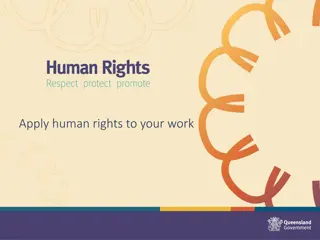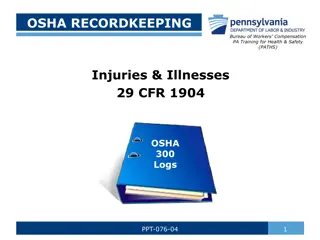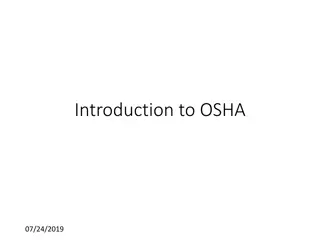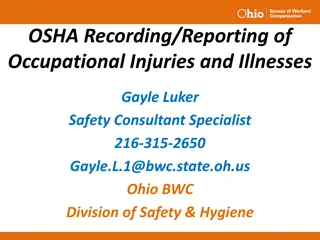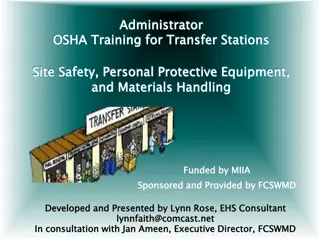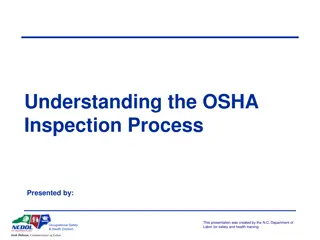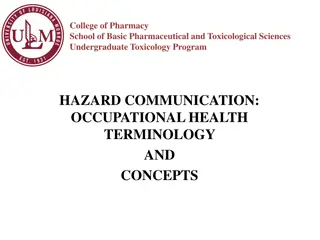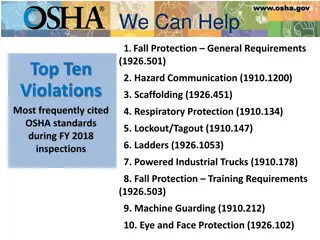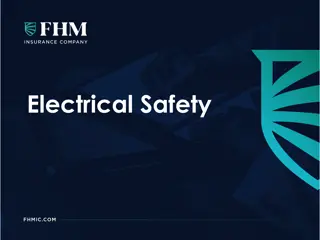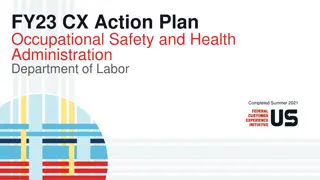Understanding OSHA: Importance, Rights, and Responsibilities
Learn about the importance of OSHA in ensuring worker safety, your rights under OSHA regulations, the responsibilities of employers, OSHA standards, inspection procedures, and where to seek help. Explore the history and mission of OSHA, and understand the key rights you have as a worker to a safe workplace. Empower yourself with knowledge to advocate for occupational safety and health.
Download Presentation

Please find below an Image/Link to download the presentation.
The content on the website is provided AS IS for your information and personal use only. It may not be sold, licensed, or shared on other websites without obtaining consent from the author. Download presentation by click this link. If you encounter any issues during the download, it is possible that the publisher has removed the file from their server.
E N D
Presentation Transcript
Lesson Overview Purpose: To provide workers with introductory information about OSHA Topics: 1. Why is OSHA important to you? 2. What rights do you have under OSHA? 3. What responsibilities does your employer have under OSHA? 4. What are OSHA standards? 5. How are OSHA inspections conducted? 6. Where can you go for help? 1
Worker Rights Handout #1: OSHA Poster Have you seen this poster at your place of work? Why was OSHA created? 2
Introduction to OSHA
Topic 1: Why is OSHA Important to You? 5,250 workers were killed on the job in 2019 OSHA Makes a Difference Worker deaths in America are down on average, from about 38 worker deaths a day in 1970 to 12 a day in 2013. Worker injuries and illnesses are down from 10.9 incidents per 100 workers in 1972 to 3.0 per 100 in 2012. 4.5 million work related injuries in 2017 Cost over $161.5 Billion in 2018 4
History of OSHA OSHA stands for the Occupational Safety and Health Administration, an agency of the U.S. Department of Labor OSHA s responsibility is to improve worker safety and health protection On December 29, 1970, President Nixon signed the OSH Act This Act created OSHA, the agency, which formally came into being on April 28, 1971 5
OSHAs Mission The mission of OSHA is to assure safe and healthful working conditions for working men and women by setting and enforcing standards and by providing training, outreach, education and assistance. Protect the safety and health of America s workers 6
OSHAs Mission Some of the things OSHA does to carry out its mission are: Developing job safety and health standards and enforcing them through worksite inspections Providing training programs to increase knowledge about occupational safety and health 7
What Rights Do You Have Under OSHA? You have the right to: A safe and healthful workplace Know about hazardous chemicals Report injury to employer Complain or request hazard correction from employer Training Hazard exposure and medical records File a complaint with OSHA Participate in an OSHA inspection Be free from retaliation for exercising safety and health rights 8
Your Right to Worker Protection is Law: The Occupational Safety and Health Act of 1970 (OSH Act) OSHA was created to provide workers the right to a safe and healthful workplace It is the duty of the employers to provide workplaces that are free of known dangers that could harm their employees This law also gives workers important rights to participate in activities to ensure their protection from job hazards 9
Your Right to Employers must have a written, complete hazard communication program that includes information on: Container labeling, Safety Data Sheets (SDSs), and Worker training. The training must include the physical and health hazards of the chemicals and how workers can protect themselves The Hazard Communication Standard (HCS) requires chemical manufacturers, distributors, or importers to provide Safety Data Sheets (SDSs) (formerly known as Material Safety Data Sheets or MSDSs) to communicate the hazards of hazardous chemical products. As of June 1, 2015, the HCS will require new SDSs to be in a uniform format. 10
Your Right to OSHA s Recordkeeping rule requires most employers with more than 10 workers to keep a log of injuries and illnesses Workers have the right to report an injury* and review current log Workers also have the right to view the annually posted summary of the injuries and illnesses (OSHA 300A) *It is against the OSHA law to retaliate or discriminate against a worker for reporting an injury or illness 11
Your Right to Workers may bring up safety and health concerns in the workplace to their employers without fear of discharge or discrimination OSHA rules protect workers who raise concerns to their employer or OSHA about unsafe or unhealthful conditions in the workplace 12
Your Right to Workers have a right to get training from employers on a variety of health and safety hazards and standards that employers must follow Some required training covers topics such as, chemical hazards, equipment hazards, noise, confined spaces, fall hazards in construction, personal protective equipment, along with a variety of other subjects Training must be in a language and vocabulary workers can understand 13
Your Right to Workers may file a confidential complaint with OSHA if they believe a violation of a safety or health standard, or an imminent danger situation, exists in the workplace Note: Often the best and fastest way to get a hazard corrected is to notify your supervisor or employer. Workers may request that their name not be revealed to the employer If a worker files a complaint, they have the right to find out OSHA s action on the complaint and request a review if an inspection is not made 14
Your Right to Employee representative can accompany OSHA inspector Workers can talk to the inspector privately Workers may point out hazards, describe injuries, illnesses or near misses that resulted from those hazards and describe any concern you have about a safety or health issue Workers can find out about inspection results, abatement measures and may object to dates set for violation to be corrected 15
Your Right to Workers have the right to be free from retaliation for exercising safety and health rights Workers have a right to seek safety and health on the job without fear of punishment This right is spelled out in Section 11(c) of the OSH Act Workers have 30 days to contact OSHA if they feel they have been punished for exercising their safety and health rights 16
Provide a workplace free from recognized hazards and comply with OSHA standards Provide training required by OSHA standards Keep records of injuries and illnesses Provide medical exams when required by OSHA standards and provide workers access to their exposure and medical records Not discriminate against workers who exercise their rights under the Act (Section 11(c)) Post OSHA citations and hazard correction notices Provide and pay for most PPE 17
Employer Responsibilities REPORTING AND RECORDING CHECKLIST Employers must: Report each worker death to OSHA Report each work-(1)related hospitalization, amputation, or loss of an eye Maintain injury & illness records Inform workers how to report an injury or illness to the employer Make records available to workers Allow OSHA access to records Post annual summary of injuries & illnesses REPORTING AND RECORDING CHECKLIST 18
What are OSHA Standards? OSHA standards are: Rules that describe the methods employers must use to protect employees from hazards Designed to protect workers from a wide range of hazards Four Groups of OSHA Standards General Industry* Construction Maritime Agriculture *General Industry is the set that applies to the largest number of workers and worksites Where there are no specific standards, employers must comply with the General Duty Clause of the OSH Act. 19
OSHA Standards (cont.) These standards also: Limit the amount of hazardous chemicals, substances, or noise that workers can be exposed to Require the use of certain safe work practices and equipment Require employers to monitor certain hazards and keep records of workplace injuries and illnesses 20
The OSH Act authorizes OSHA compliance safety and health officers (CSHOs) to conduct workplace inspections at reasonable times OSHA conducts inspections without advance notice, except in rare circumstances (e.g. Imminent Danger) In fact, anyone who tells an employer about an OSHA inspection in advance can receive fines and a jail term 21
Different Types of OSHA Inspections Imminent danger Fatality or hospitalizations Worker complaints/referrals Targeted inspections Local Emphasis Program (LEP), National Emphasis Program (NEP), particular hazards or industries Follow-up Inspections 22 22
As of 01/01/2020 The New Maximum Penalty
VIOLATION TYPE PENALTY WILLFUL A violation that the employer intentionally and knowingly commits or a violation that the employer commits with plain indifference to the law. OSHA may propose penalties of up to $134,937 for each willful violation, with a minimum penalty of $5,000 for each willful violation. SERIOUS A violation where there is substantial probability that death or serious physical harm could result and that the employer knew, or should have known, of the hazard. There is a mandatory penalty for serious violations which may be up to $13,494 OTHER-THAN-SERIOUS A violation that has a direct relationship to safety and health, but probably would not cause death or serious physical harm. (or Failure to Abate per day) OSHA may propose a penalty of up to $13,494 or each other-than-serious violation. OSHA may propose penalties of up to $134,937 for each repeated violation. REPEATED A violation that is the same or similar to a previous violation. 24
Sources within the workplace/worksite Sources outside the workplace/worksite How to file an OSHA complaint 25
Employer or supervisor, co-workers and union representatives Safety Data Sheet (SDS) for information on chemicals Labels and warning signs Employee orientation manuals or other training materials Work tasks and procedures instruction 26
How to Raise a Concern Identifying Safety and Health Problems in the Workplace Review handout to become more aware of workplace hazards Discuss if anyone has discovered safety and/or health problems in the workplace/site 27
Download the OSHA complaint form from OSHAs website File the complaint online Workers can file a complaint A worker representative can file a complaint Telephone or visit local regional or area offices to discuss your concerns Complete the form be specific and include appropriate details OSHA determines if an inspection is necessary Workers do not have to reveal their name 28
What are some resources inside the workplace that will help you find information on safety and health issues? What are some resources outside the workplace that will help you find information on safety and health issues? 30




